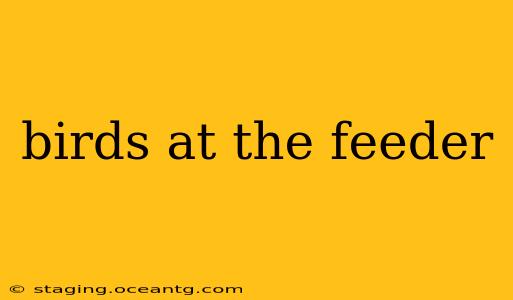Attract a vibrant array of feathered friends to your backyard with a bird feeder! It's a simple yet rewarding way to connect with nature, observe fascinating bird behaviors, and contribute to local biodiversity. This guide delves into the joys of bird feeding, offering tips and tricks to maximize your avian encounters. We'll also address common questions about attracting specific birds and ensuring the health and safety of your feathered visitors.
What types of birds visit feeders?
The types of birds that visit your feeder will largely depend on your location, the type of feeder you use, and the type of food you provide. Common feeder visitors include cardinals, chickadees, finches, sparrows, jays, woodpeckers, and nuthatches. Offering a variety of feeders and food sources will attract the greatest diversity of species. For example, tube feeders with perches are ideal for smaller birds, while platform feeders are better suited for larger birds like doves or jays.
What is the best bird food to use?
Different birds have different dietary preferences. A mix of seeds, such as sunflower seeds (black oil sunflower seeds are a favorite!), nyjer seeds (for finches), and white-striped sunflower seeds, offers a good starting point. Suet is a high-energy food perfect for woodpeckers and nuthatches during colder months. You can also offer fruit, like oranges or apples, and even nectar for hummingbirds. Avoid moldy or spoiled food, as this can harm birds.
How often should I refill my bird feeder?
The frequency of refilling depends on the size of your feeder, the number of birds visiting, and the type of food. As a general guideline, check your feeder daily, especially during peak feeding times (winter months) and refill when it's about half empty. Regularly cleaning your feeder will also prevent the spread of disease.
How do I keep squirrels away from my bird feeder?
Squirrels are notorious bird feeder raiders! Several strategies can help deter them. You can use squirrel-resistant feeders with cages or baffles that prevent squirrels from reaching the food. Alternatively, you can position your feeder in a location that is difficult for squirrels to access, such as hanging it from a sturdy branch far from trees or other climbing structures.
What are the benefits of having a bird feeder?
Beyond the simple pleasure of watching birds, there are several benefits to having a bird feeder. It provides a reliable food source for birds, particularly during harsh weather conditions. Bird feeders also enhance your backyard's biodiversity, bringing a variety of species into your immediate environment. This can enrich your understanding of the natural world and provide hours of enjoyable observation.
How can I attract specific birds to my feeder?
Attracting specific bird species often requires tailoring your feeder and food offerings to their preferences. Research the dietary habits of the birds you wish to attract. For example, hummingbirds are attracted to nectar feeders, while woodpeckers prefer suet. Providing the right food and feeder type significantly increases your chances of attracting your desired avian guests.
Are there any dangers associated with bird feeders?
While bird feeders offer significant benefits, there are potential drawbacks. Improperly cleaned feeders can spread disease among birds. Predators, such as cats, might be attracted to the area. Providing the wrong type of food could unintentionally harm birds. Therefore, maintaining a clean feeder, choosing appropriate food, and being mindful of predator access are crucial for responsible bird feeding.
How can I make my bird feeder more bird-friendly?
Creating a bird-friendly environment extends beyond simply providing food. Planting native shrubs and trees provides natural cover and nesting sites. Providing a clean water source, like a birdbath, is also essential. Avoiding the use of pesticides and herbicides helps protect birds from harmful chemicals. By creating a diverse and safe habitat, you will enhance your chances of attracting a wider variety of birds.
By following these tips, you can transform your backyard into a thriving bird sanctuary, offering a delightful spectacle of avian activity and contributing to the conservation of local bird populations. Remember, responsible bird feeding requires consistent effort, attention to detail, and a genuine appreciation for the wonder of these fascinating creatures.
